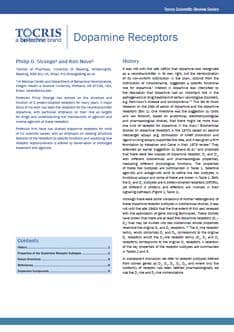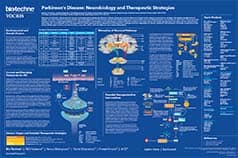D4 Receptors
D4 receptors are members of the dopamine receptor G-protein-coupled receptor family that also includes D1, D2, D3 and D5. They are located primarily in the frontal cortex, midbrain, amygdala and the cardiovascular system. A role in cognition and emotion has been proposed.
D4 Receptor Agonists |
|
|---|---|
| Cat. No. | 产品名称/活性 |
| 4552 | A 412997 dihydrochloride |
| Selective D4 agonist | |
| 1065 | PD 168077 maleate |
| High affinity, selective D4 agonist | |
| 4380 | WAY 100635 maleate |
| D4 agonist; also potent 5-HT1A antagonist | |
D4 Receptor Antagonists |
|
| Cat. No. | 产品名称/活性 |
| 1004 | L-741,742 hydrochloride |
| Highly selective D4 antagonist | |
| 1002 | L-745,870 trihydrochloride |
| Highly selective D4 antagonist | |
| 3529 | PD 168568 dihydrochloride |
| Potent and selective D4 antagonist | |
D4 receptors are members of the dopamine receptor G-protein-coupled receptor family that also includes D1, D2, D3 and D5. They are located primarily in the frontal cortex, midbrain, amygdala and the cardiovascular system. The function of the D4 receptor is unknown, although a role in cognition and emotion has been proposed. The human D4 receptor gene has been localized to chromosome 11 (11q15.5).
External sources of pharmacological information for D4 Receptors :
Literature for D4 Receptors
Tocris offers the following scientific literature for D4 Receptors to showcase our products. We invite you to request* your copy today!
*Please note that Tocris will only send literature to established scientific business / institute addresses.
Dopamine Receptors Scientific Review
Written by Phillip Strange and revised by Kim Neve in 2013, this review summarizes the history of the dopamine receptors and provides an overview of individual receptor subtype properties, their distribution and identifies ligands which act at each receptor subtype. Compounds available from Tocris are listed.
Addiction Poster
The key feature of drug addiction is the inability to stop using a drug despite clear evidence of harm. This poster describes the brain circuits associated with addiction, and provides an overview of the main classes of addictive drugs and the neurotransmitter systems that they target.
Parkinson's Disease Poster
Parkinson's disease (PD) causes chronic disability and is the second most common neurodegenerative condition. This poster outlines the neurobiology of the disease, as well as highlighting current therapeutic treatments for symptomatic PD, and emerging therapeutic strategies to delay PD onset and progression.


